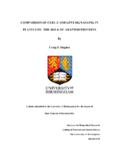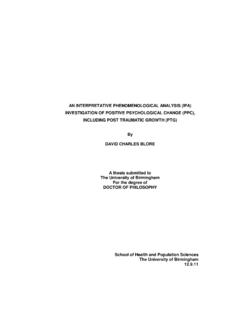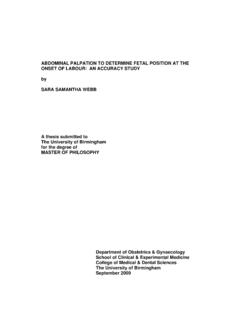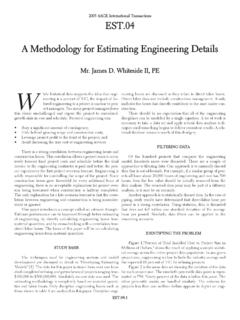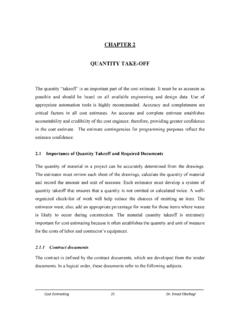Transcription of THE ROLE OF COST ESTIMATORS IN UK …
1 THE ROLE OF cost ESTIMATORS IN UK construction ; A CASE FOR AND STEPS towards AN estimating PROFESSION By JAMES ARTHUR HACKETT A thesis submitted to The University of Birmingham For the degree of DOCTOR OF PHILOSOPHY College of Engineering and Physical Sciences School of Civil Engineering The University of Birmingham December 2010 University of Birmingham Research Archive e-theses repository This unpublished thesis/dissertation is copyright of the author and/or third parties. The intellectual property rights of the author or third parties in respect of this work are as defined by The Copyright Designs and Patents Act 1988 or as modified by any successor legislation. Any use made of information contained in this thesis/dissertation must be in accordance with that legislation and must be properly acknowledged. Further distribution or reproduction in any format is prohibited without the permission of the copyright holder.
2 To Fran her love and passion for her mature ladies , dogs, birds, whales, dolphins, wild animals, organic vegetables, plants, garden, compost heaps and cooking, knows no bounds. She has many other interests and desires but I m drawing a line at donkeys, goats and chickens - for all she does and all the dark times that she s fought her way through I dedicate this thesis with all my love. Abstract ESTIMATORS and Quantity Surveyors (QS) have pivotal roles in the profitability of construction contracts; however, only QSs have professional recognition. Comparisons between these groups suggested that this may be an anomaly. The purpose of this thesis was to consider the role of the estimator relative to the accepted criteria attaching to professional status. To achieve this, definitions of a profession were used to compare QSs and ESTIMATORS in terms of remuneration, education and professional representation.
3 A statistical analysis on each of these conditions suggested that there was no significant difference in terms of salary offered or education required, by employers. Further investigation, however, did reveal considerable differences in educational and professional opportunities, favouring QSs. With regard to the key defining criteria of a profession and the consideration given by employers, the results indicated that there was no difference between the two groups. Further surveys developed proposals for an estimator Body of Knowledge (BoK) and Training Needs Analysis (TNA) and also found a changing role in meeting diverse client-driven procurement methods and employer requirements. As this demonstrated a case for professional recognition to be considered then these proposals could be used as a platform for further development. Acknowledgements With great appreciation of their knowledge and vast experience, unselfishly passed to me whenever it was needed, I offer my gratitude to: Chloe Hackett - read this work over and over without complaint, even though she has no particular interest in the subject and has more than enough to do in her busy life.
4 Her patience, understanding, support and encouragement have never wavered. Her knowledge has been unselfishly shared with me, which has made the production easier and improved the presentation beyond that which I could otherwise have achieved. I love her dearly and am extremely proud of all the amazing things she does. Professor John Perry - ensured that the thesis stayed focused, expertly pulled all its pieces together, knocked off the rough edges, gave me the benefit of his extensive engineering and construction expertise, kept my feet on the ground and backed me to the hilt when the chips were down. Professor Carolyn Hicks - formed the structure and with her peerless statistical input, patient guidance and unerring judgement gave me the confidence to take this on. Her knowledge aided me when I was struggling and proved invaluable in the development of the case and its final presentation. Mrs Janet Fasci A Lioness in a skirt and there for me when I needed help, as she was for all her students.
5 She ll be sorely missed and I wish her a long, healthy and happy retirement Doctor Julian Lamb - encouraged me to do this, for which I owe him a debt of gratitude, and who gave the thesis a perspective on socialisation that it wouldn t have had Table of Contents CHAPTER 1 - INTRODUCTION .. 3 CHAPTER 2 - RESEARCH METHOD .. 17 CHAPTER 3 - 25 RESEARCH METHOD .. 25 Methodology .. 27 Results .. 29 Conclusions .. 56 CHAPTER 4 - estimator MATCH TO DEFINED PROFESSIONAL CRITERIA .. 58 RESEARCH METHOD .. 58 Methodology .. 58 Results .. 59 Conclusions .. 62 CHAPTER 5 - PILOT estimator INTERVIEWS .. 63 RESEARCH METHOD .. 64 Methodology .. 64 Results .. 69 Conclusions .. 77 CHAPTER 6 - estimator -QS SALARY AND BENEFITS COMPARISON .. 79 RESEARCH METHOD .. 80 Methodology .. 83 Results .. 92 Conclusions .. 103 CHAPTER 7 - estimator -QS JOB ATTRIBUTE COMPARISON .. 104 RESEARCH METHOD.
6 104 Methodology .. 105 Results .. 108 Conclusions .. 121 CHAPTER 8 - estimator -QS EDUCATIONAL AVAILABILITY COMPARISON .. 123 RESEARCH METHOD .. 124 Methodology .. 124 Results .. 128 Conclusions .. 135 CHAPTER 9 - DELPHI STUDY .. 138 RESEARCH METHOD .. 138 Methodology .. 141 Results .. 147 Conclusions .. 153 CHAPTER 10 - ETHNOGRAPHICAL 156 RESEARCH METHOD .. 162 Methodology .. 165 Results .. 170 Conclusions .. 171 2 CHAPTER 11 - estimator SKILLS QUESTIONNAIRE .. 172 RESEARCH METHOD .. 172 Methodology .. 173 Results .. 179 Conclusions .. 192 CHAPTER 12 - estimator TRAINING NEEDS ANALYSIS .. 195 RESEARCH METHOD .. 198 Methodology .. 198 Results .. 209 TNA Instrument .. 211 Conclusions .. 220 CHAPTER 13 DISCUSSION .. 222 CHAPTER 14 - CONCLUSIONS AND RECOMMENDATIONS .. 235 CONCLUSIONS .. 235 Recommendations for the CI .. 237 REFERENCES .. 240 APPENDICES.
7 266 APPENDIX 1 RESEARCH STRATEGIES .. 267 APPENDIX 2 estimator -QS JOB ADVERTISEMENT DETAILS .. 290 APPENDIX 3 estimating /TENDERING MODULE CONTENT TABLES FROM HE .. 309 APPENDIX 3 estimating /TENDERING MODULE CHARTS .. 322 APPENDIX 4 DELPHI STUDY ROUND 2 QUESTIONNAIRE .. 329 APPENDIX 4 KENDAL TEST DISPLAYING AVERAGE MARKS .. 335 APPENDIX 4 MAIN AND INDIVIDUAL ATTRIBUTES COLLECTED FROM DELPHI STUDY .. 336 APPENDIX 5 ETHNOGRAPHICAL STUDIES .. 344 APPENDIX 6 estimator TRAINING NEEDS QUESTIONNAIRE .. 370 APPENDIX 7 PUBLISHED ARTICLE FOR ECAM JOURNAL .. 375 APPENDIX 8 estimating COMPARISON UK-US .. 407 APPENDIX 9 estimator EDUCATION AND TRAINING ADOPTION BY THE CI .. 419 GLOSSARY OF ABBREVIATIONS .. 456 3 Chapter 1 - Introduction For over twenty years computer software programs have been made available that were designed to improve the standards of estimating and greatly increase the speed of flow of tender information between clients representatives, contractors, sub-contractors and suppliers.
8 From personal experience and discussions with peers in the UK construction industry (CI), there were increasing frustrations that full advantage was not being taken of these advances. As it was difficult to know whether this was due to a lack of investment by employers or the inability of ESTIMATORS to adapt to new technologies it was originally decided to investigate the problem to discover the reasons for the perceived slow take-up of information technology (IT). The research quickly unearthed what appeared to be a major deficiency in the estimating role with evidence of neglect in the fundamental area of specific education and training for ESTIMATORS . This would partially explain the slow take-up of IT, particularly with the adoption of computer aided estimating (CAE). If this was factual, it meant that CI employers were taking serious risks by allowing ESTIMATORS to carry out such a vital financial function without the benefit of specialised education and training.
9 As the accuracy of a nett cost estimate was pivotal to the success and/or failure of every CI company, the emphasis of the research was placed onto discovering what ESTIMATORS do. Given that almost every CI engineering and construction company relies upon ESTIMATORS to win contracts, it would be expected that these employers would place a high value on the estimating role. It would also be assumed that they would want to have confidence in the capability of their ESTIMATORS to carry out the work to the highest standards, with the ability to operate CAE software and other software programmes within their IT networks. Therefore, if the estimating role merited a specific education and training programme (ETP) then it may also be worthy of acquiring professional status. If that was feasible, the upgraded position of the role would benefit employers by attracting individuals with assured ability. It would also present estimating in a more attractive light to prospective candidates of the required ability.
10 4 Researching available literature gave indications of reasons for the deficiency in estimator ETPs. Some authors regarded estimating as being both a hit-and-miss procedure and one that had too many variables for it to be carried out with consistent accuracy. Others emphasised the vital nature of the role in construction company profitability. Literature was also found that highlighted changes in the way in which the CI was carrying out its projects. These changes were shown to be increasing the demands and attribute requirements of ESTIMATORS from both clients and employers. In general, these appraisals presented a picture of the CI as one heavily reliant for its survival and prosperity upon an apparently unreliable procedure. Despite this, the industry did not appear to be sufficiently concerned that it felt it necessary to change its approach to estimator training, even though the difficulty of producing accurate estimates was widely acknowledged and the challenges of changes in procurement methods were extending the range of estimator skills.

